Discovering the Cashew Tree - Appearance and Characteristics

1. General description of the cashew tree
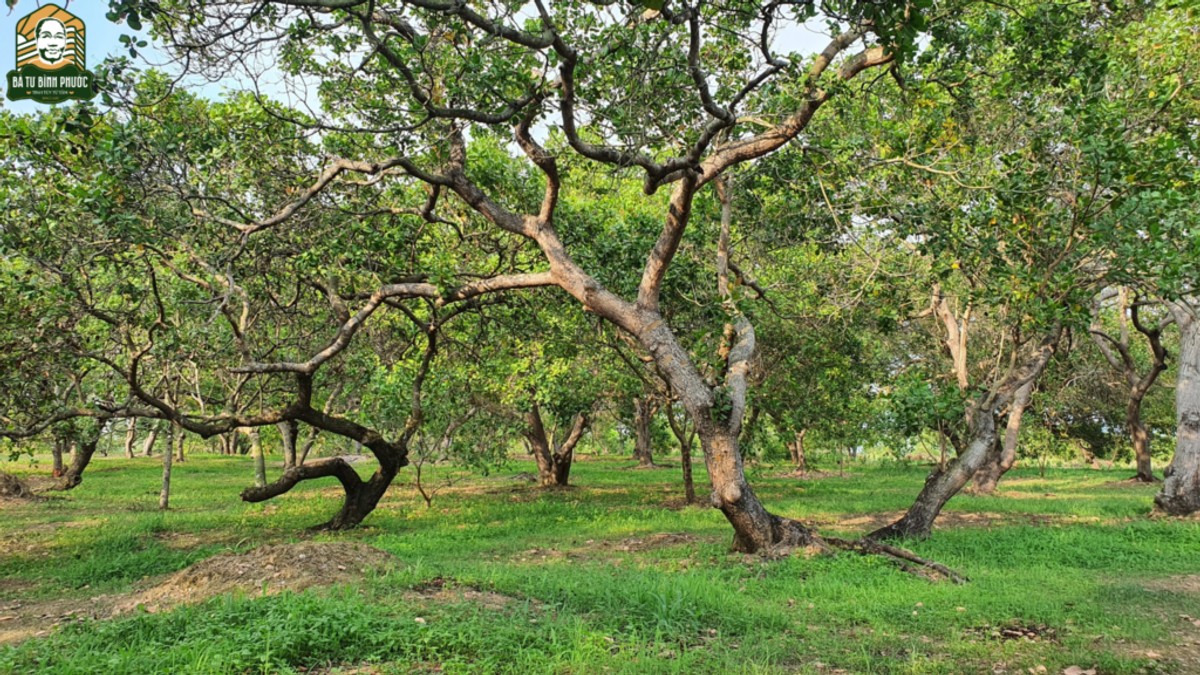
Cashew trees (Anacardium occidentale) are fascinating and versatile plants. Here's a general description of what they look like:
Appearance
- Size: Cashew trees are medium-sized, typically growing to about 10-12 meters (33-40 feet) in height.
- Canopy: They have a broad, spreading canopy with a rounded crown, providing ample shade.
- Leaves: The leaves are simple, oval-shaped, and leathery with a smooth surface. They are bright green and can grow up to 22 centimeters (8.7 inches) long.
- Flowers: The tree produces small, fragrant flowers that are typically pinkish in color. These flowers grow in clusters at the tips of the branches.
Fruit
- Cashew Apple: The cashew apple is a pear-shaped, fleshy structure that is yellow or red when ripe. It is technically the swollen stem of the tree, not a true fruit.
- Cashew Nut: The cashew nut grows at the bottom of the cashew apple. It is kidney-shaped and encased in a hard shell that contains a toxic oil called urushiol.
Growth Conditions
- Climate: Cashew trees thrive in tropical climates with plenty of sunlight and well-drained soil. They are drought-tolerant and can grow in sandy or rocky soils.
- Geographical Distribution: They are primarily cultivated in countries such as India, Vietnam, Nigeria, and Brazil.
Economic Importance
Cashew trees are economically significant as they produce both the cashew apple and the cashew nut. The nuts are highly valued for their nutritional content and versatility in cooking, while the apples are used in various food and beverage products.
2. Cashew tree trunk
The trunk of a cashew tree is quite distinctive:
Appearance

- Size and Shape: The trunk of a mature cashew tree is often thick and robust, supporting the broad, spreading canopy. It typically has a diameter of about 30 to 50 centimeters (12 to 20 inches) at breast height.
- Bark: The bark is rough and grayish-brown, with a slightly fissured surface. It can appear somewhat scaly or cracked in older trees.
- Branches: The trunk gives rise to several strong, spreading branches that form the wide canopy of the tree.
Function
- Support: The sturdy trunk supports the extensive canopy, which provides shade and protection for the tree's delicate flowers and fruits.
- Nutrient Transport: As with all trees, the trunk is crucial for the transport of water, nutrients, and food between the roots and the leaves.
Growth
- Tropical Climates: Cashew trees thrive in tropical regions with ample sunlight and well-drained soil. They are resilient to dry conditions and can grow in poor soil, making them well-suited to various challenging environments.
Understanding the structure of the cashew tree trunk helps you appreciate its resilience and the vital role it plays in the tree's growth and productivity.
3. Cashew tree roots
The roots of the cashew tree play a crucial role in its growth and stability. Here's a detailed look at them:
Structure and Function
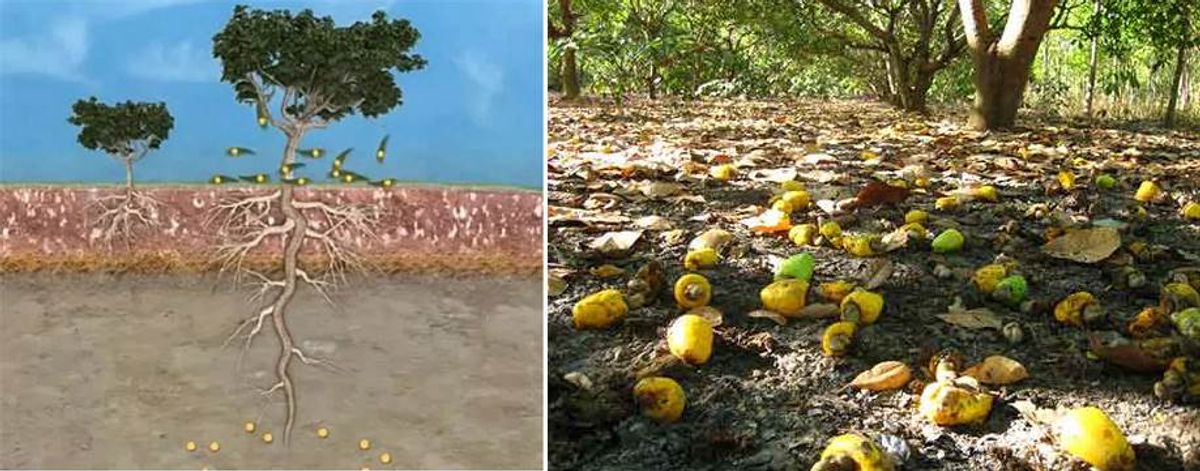
- Taproot System: Cashew trees typically have a strong, central taproot that anchors the tree deeply into the ground. This taproot helps the tree access water and nutrients from deeper soil layers.
- Lateral Roots: In addition to the taproot, cashew trees have a network of lateral roots that spread out horizontally. These roots help stabilize the tree and absorb water and nutrients from the upper layers of soil.
Soil and Climate Adaptation
- Soil Tolerance: Cashew tree roots are adapted to a variety of soil types, including sandy, loamy, and rocky soils. They are particularly well-suited to well-drained soils.
- Drought Resistance: The deep taproot allows the cashew tree to access water from deeper soil layers, making it more resilient to drought conditions. This is one reason why cashew trees thrive in tropical regions with variable rainfall.
Importance in Tree Health
- Nutrient Uptake: The extensive root system is essential for the absorption of nutrients, which support the tree's growth, flowering, and fruit production.
- Stability: The robust root structure provides stability and helps the tree withstand strong winds and adverse weather conditions.
Understanding the root system of the cashew tree highlights its resilience and adaptability, crucial traits for thriving in diverse and often challenging environments.
4. Cashew tree leaves
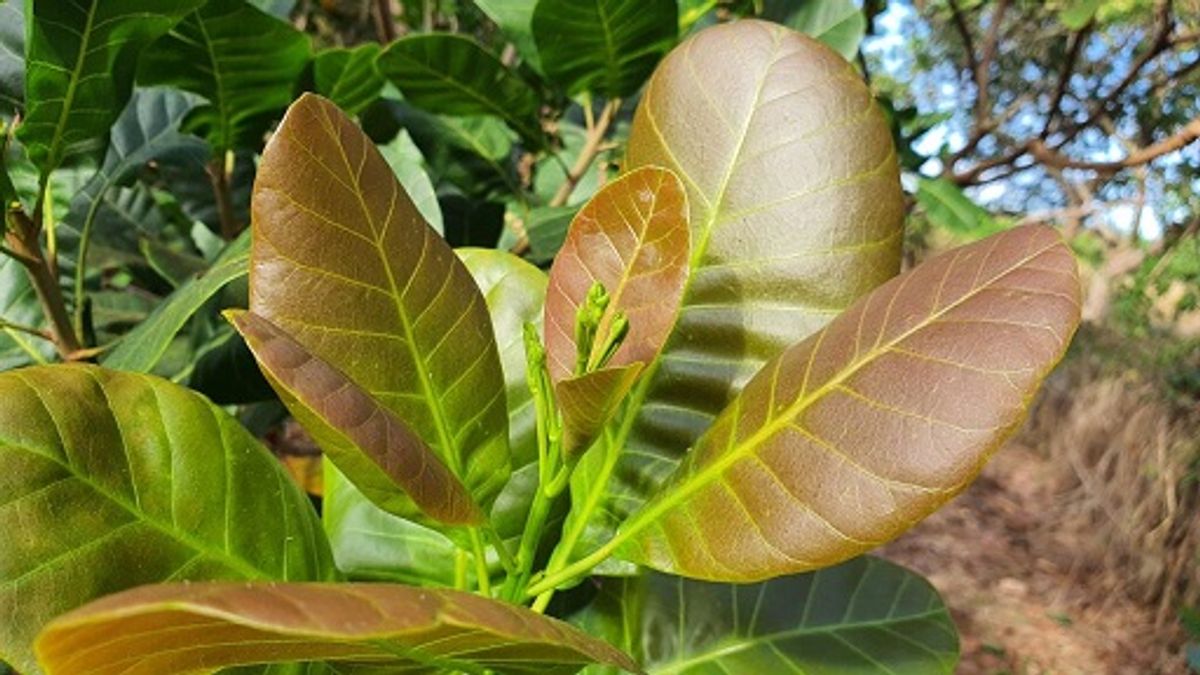
Cashew tree leaves are quite distinctive and play an essential role in the health and function of the tree:
Appearance
- Shape: The leaves are simple, oval-shaped, and have a smooth, leathery texture.
- Size: They typically grow up to 22 centimeters (8.7 inches) long and about 15 centimeters (5.9 inches) wide.
- Color: The leaves are bright green when young and can turn darker green as they mature.
- Surface: The surface of the leaves is glossy, adding a vibrant look to the tree.
Function
- Photosynthesis: Like all green leaves, cashew tree leaves are essential for photosynthesis, converting sunlight into energy for the tree.
- Protection: The leathery texture helps protect the leaves from pests and environmental stresses.
- Water Regulation: The leaves help regulate water loss through tiny openings called stomata, which open and close to maintain the tree's hydration levels.
Growth and Adaptation
- Tropical Climates: Cashew tree leaves are adapted to thrive in tropical climates, where they receive ample sunlight and can tolerate drought conditions.
- Wind Resistance: The broad and sturdy leaves help the tree withstand strong winds, contributing to the overall resilience of the cashew tree.
These leaves are not just vital for the tree's survival but also add to the lush, green aesthetic of the cashew tree, making it a beautiful addition to tropical landscapes.
5. Cashew flowers

Cashew flowers are delicate and quite fascinating. Here’s what you need to know:
Appearance
- Size and Shape: The flowers are small and grow in clusters, often called panicles. Each flower is about 6-7 millimeters long.
- Color: They start as greenish-yellow and gradually turn pink as they mature.
- Structure: Each flower has five petals, and they are bisexual, meaning they contain both male and female reproductive organs.
Growth and Pollination
- Location: The flowers grow at the ends of the branches in large, showy clusters.
- Blooming Season: Cashew trees typically bloom during the dry season, which varies by region but often falls between November and January.
- Pollination: The flowers are mostly pollinated by insects, particularly bees. The strong fragrance of the flowers attracts these pollinators.
Significance
- Fruit Development: After successful pollination, the flowers develop into cashew apples and nuts. The nut grows first, followed by the cashew apple, which swells and ripens above the nut.
- Economic Value: Flowering is a critical stage in the cashew production cycle. Successful pollination and fruit set are vital for a good harvest, making the health and productivity of cashew flowers essential to the cashew industry.
Cashew flowers, with their unique characteristics and vital role in the development of both the cashew apple and nut, add to the allure and complexity of the cashew tree.
6. Cashew fruit
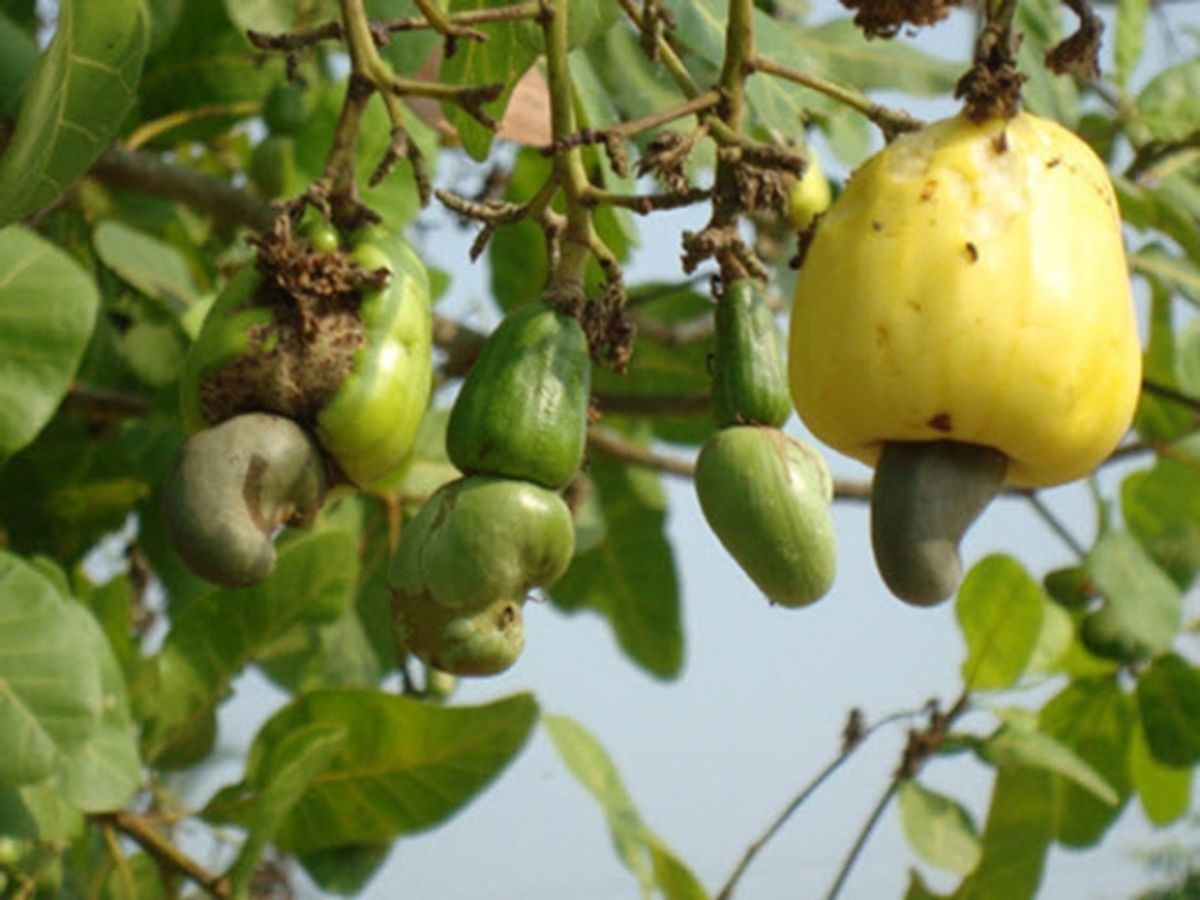
The cashew fruit is quite intriguing because it consists of two parts: the cashew apple and the cashew nut.
Cashew Apple
- Appearance: The cashew apple is a swollen stem of the tree, usually yellow or red, pear-shaped, and juicy.
- Taste: It's sweet with a slightly astringent flavor.
- Uses: Often eaten fresh or made into juice, jams, chutneys, and alcoholic beverages like feni in Goa, India.
- Nutritional Value: Rich in vitamin C, calcium, and other nutrients.
Cashew Nut
- Appearance: The nut grows at the bottom of the cashew apple, kidney-shaped and encased in a hard, toxic shell.
- Uses: After removing the toxic shell through roasting or steaming, the nuts are consumed raw, roasted, or used in various recipes.
- Nutritional Value: Packed with healthy fats, proteins, vitamins, and minerals.
Processing
- Harvesting: The cashew apples are collected from the trees.
- Separation: The nut is separated from the apple.
- Roasting/Steaming: The nuts are roasted or steamed to soften the shells and neutralize the toxic oil.
- Shelling: The shells are then removed, either manually or with machinery, to extract the kernel.
- Peeling: The thin, inner skin of the nut is peeled away.
- Drying: The kernels are dried to reduce moisture content and enhance shelf life.
- Grading: The cashews are graded based on size and quality before packaging.
Significance
- Economic Value: Cashew nuts are highly valued for their nutritional content and versatility in cooking. The cashew apple, although less known, is also used in various culinary applications.
- Geographical Distribution: Primarily grown in tropical regions like India, Vietnam, Nigeria, and Brazil, cashew trees support the livelihoods of millions of farmers and workers.
The cashew fruit, with its unique structure and versatile uses, is truly a remarkable plant. Whether you enjoy the juicy cashew apple or the nutrient-rich cashew nut, you're getting a taste of something special.
7. Cashew
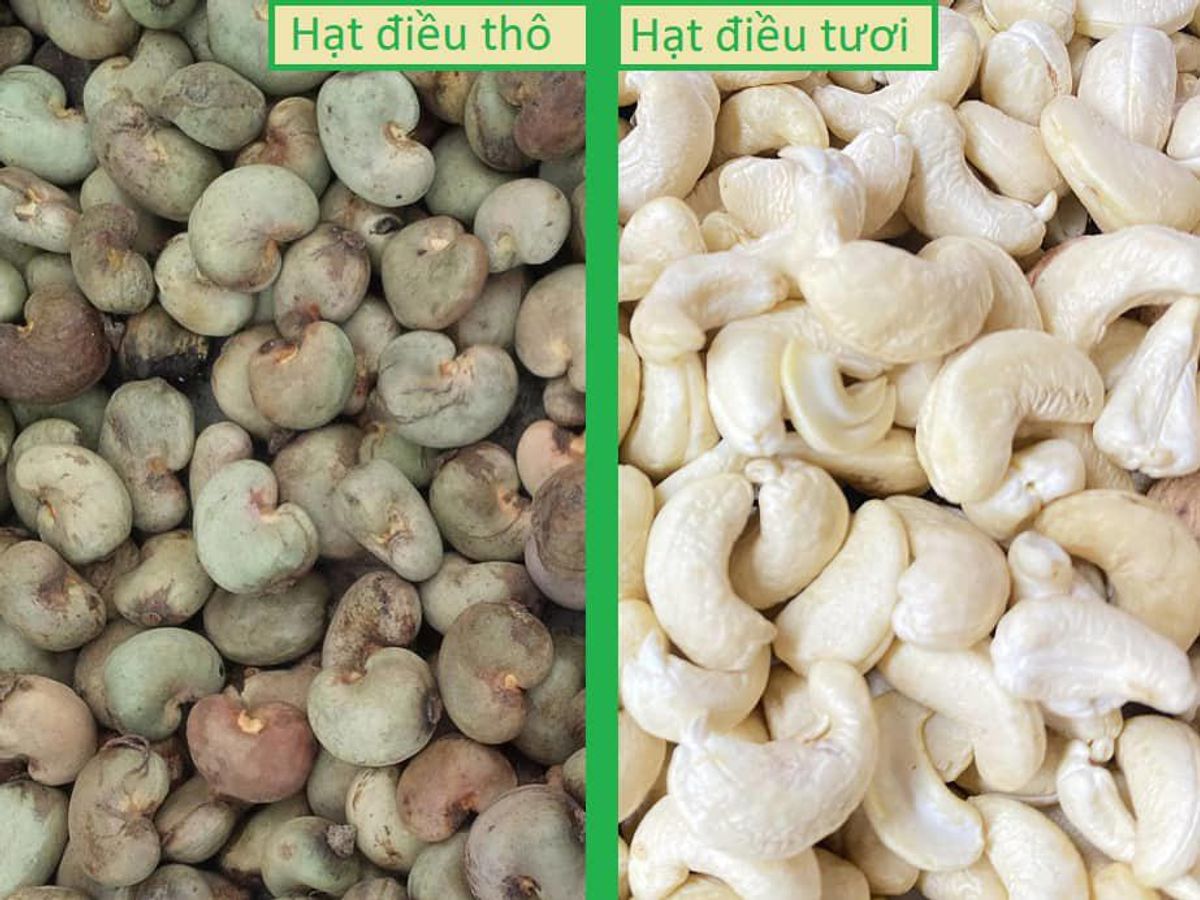
Cashew trees (Anacardium occidentale) are native to Brazil but are now widely cultivated in tropical regions around the world, including India, Vietnam, and Africa.
Cashew Fruit
- Cashew Apple: This is the fleshy, pear-shaped structure that grows from the cashew tree. It is edible, juicy, and often used in beverages and preserves. Cashew Nut: The nut grows at the bottom of the cashew apple and is encased in a hard, toxic shell. The nut itself is what we commonly refer to as cashew and is highly nutritious.
Nutritional Value (per 28 grams of cashew nuts)
- Calories: 156 kcal
- Protein: 5.17 g
- Fat: 12.43 g
- Carbohydrates: 8.56 g
- Fiber: 0.94 g
- Vitamins: Rich in Vitamin K, Vitamin B6
- Minerals: Magnesium, Zinc, Iron, Copper
Health Benefits
- Heart Health: Cashews contain heart-healthy fats that can help reduce cholesterol levels.
- Bone Health: High in magnesium and phosphorus, which are essential for strong bones.
- Energy: Cashews provide a quick energy boost thanks to their healthy fats and protein content.
- Immune System: The minerals and vitamins in cashews boost the immune system.
Processing
- Harvesting: Cashew apples and nuts are harvested.
- Separation: Nuts are separated from the apples.
- Roasting/Steaming: Nuts are roasted or steamed to remove the toxic shell.
- Shelling: Shells are removed to extract the kernel.
- Drying: Kernels are dried to reduce moisture content.
- Grading: Cashews are graded and packaged
Fun Facts
- Name Origin: The term "cashew" comes from the Portuguese word "caju," derived from the indigenous Tupi word "acajú."
- Versatility: Cashews are used in various forms, including raw, roasted, salted, as butter, and even as milk.
Cashews are not just delicious; they’re also packed with nutrients and have numerous health benefits.
Xem thêm: Nguồn gốc xuất xứ của cây điều - Đặc điểm nguyên thủy & Quá trình du nhập ra thế giới
Learn more: Origin of cashew tree - Original characteristics & Process of introduction to the world